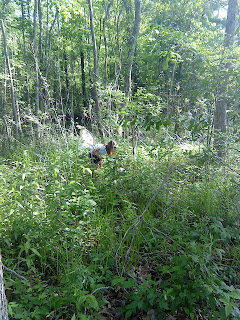We did turn in record books after all was said and done. Sean turned in a record book for entomology and it was amazing! Henry at the last minute decided he wanted to have a record book also...so we rushed to throw together a book for the Wildlife & Fisheries project. Then we were called two days later to change the category because the entomology project had been eliminated. So...we quickly revamped his book to make it a Wildlife & Fisheries project! We were not the least surprised to have the comment from a judge that the two brothers sounded a lot alike! Unfortunately, Henry was the one counted off for this error...the original thoughts were his! However, in both of their defense...they were doing the same project and were both leaders so it makes sense that their stories would sound the same.
Both of the boys had their record books advance to the district level. This was the highest level for Henry and he was given a blue ribbon. Sean placed first in his senior level and advanced to the state level. He then placed 4th place overall. Not bad considering our sudden change of books (Side note: I was just told this past week b a judge at this level that they were very impressed with his book and he had a lot of tough competitors. So proud of Sean and all he has accomplished!). We also found out that the district was mistaken about the book categories...entomology IS still a category! That is OK...it is always good to have a challenge....Sean did well in spite of this handicap...all is good and we can try with entomology again next year.
We did get Sean's application turned in for the Gold Star award as well. He interviewed (with a borrowed suit jacket) and did a great job. His interview was very brief but from what we were told the other applicants had short interviews as well. I was impressed with the answers Sean gave for the interview questions...
If you could add an H to the pledge, what would it stand for? Honor because we should be honest with those around us.
What was his favorite experience in 4H? His time in community service, especially making quilts for the women's shelter.
What is your favorite project? Entomology...of course!
If you were a new parent, what would you want to know about 4H? The importance of learning in the projects and the leadership opportunities.
SO...now jump ahead a month!
We decided that the best option for our family was to choose a new club to settle back into our new role in 4H. We are now a part of Blue Ribbon 4H. It has been different but fun to watch without all the responsibility. We will likely be moving by the end of the year so this is a good pace for us.
 We also stepped back from one of our favorite projects...Wildlife. This was hard but we really could not participate fully...we will try to pick it up again next year if we can. This opened the door for a new project being offered in our county (and in the new county)...archery! We will see wher we go with it...still taking it slow for now.
We also stepped back from one of our favorite projects...Wildlife. This was hard but we really could not participate fully...we will try to pick it up again next year if we can. This opened the door for a new project being offered in our county (and in the new county)...archery! We will see wher we go with it...still taking it slow for now.Tonight we went to the Gold Star banquet. Both Sean and Henry were rewarded for their record books.
However, most of all we were awaiting the results of the Gold Star! So, we were so proud of Sean as he was one of the four (out of eleven) chosen to be awarded a Gold Star plaque! He was so excited...he got fingerprints on the plaque when he was given the award...he used his shirt to polish it! LOL!

He was also interviewed for the newspaper along with the other recipients (Cade, Mikayla and Erin)! We look forward to reading the article!
So proud of our other 4H friends. Emily and Cade were given the spirit awards. Mikayla and Preston were chosen as the teen leaders for this year. Also, Courtney was the recipient of the Danforth Award.
Sean was also pleased, as one of our local radio stations was given the Friend of 4H award...he was the one who thought to choose this business as a friend....they really do a lot to promote 4H and have never been recognized. Awesome job for that pick, Sean!
SO...a little bit of excitement and change...we continue to try to make the best better...just on a smaller scale! Urban 4H needs to watch out we are on our way!
















































